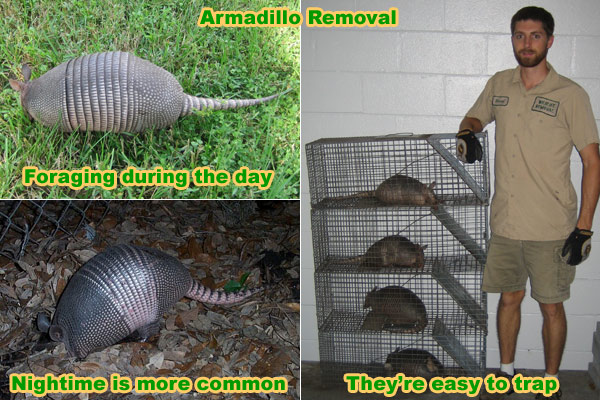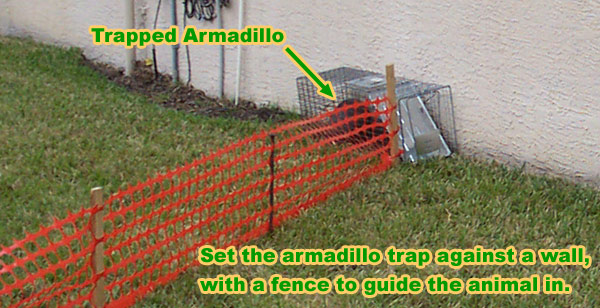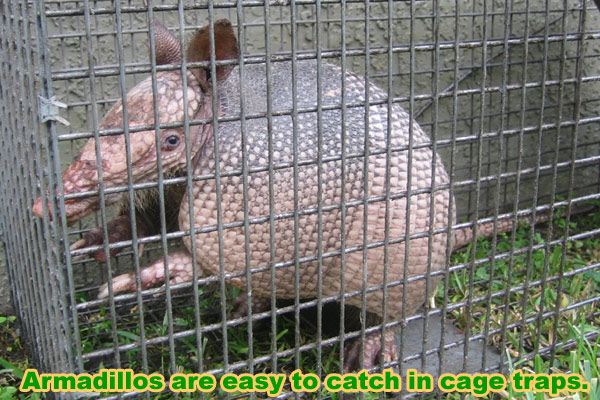- info@wildlife-removal.com
Call us for help in your town
Wildlife Removal Education
How to Trap Armadillo - Trapping Tips
Need armadillo removal in your hometown? We service over 500 USA locations! Click here to hire us in your town and check prices - updated for year 2020.
I struggled at successfully trapping armadillos during my first year as a nuisance wildlife operator. I tried many different tactics and many different types of traps.
Looking back, some of the stuff I tried was pretty strange - I tried setting up steel snares over the burrows, I tried exotic directional fencing in strange patterns,
I tried bundling a panty hose full of earthworms in the back of a trap, lots of stuff. However, through trial and error, I got really good at armadillo trapping, and
now it's incredibly easy for me. My success rate is honestly about 98%. Like about one out of fifty jobs results in no armadillo trapped. And I've learned how to
stop accidental catches of raccoons and opossums as well. Read on. And don't forget: if you have trouble and want to hire a pro like me, someone with experience,
click on this map of Professional Wildlife Removal Companies, and you'll find an expert in your town or city.

The key to trapping armadillos is in understanding their behavior. They are nocturnal animals, they live in burrows underground, they dig in the soil for their food (worms and grubs, mostly),
they have poor eyesight, they bump into things, and they dig several burrows. That gets us started.
What type of trap catches armadillos? - A live cage trap, raccoon sized, is best. At least 30 inches long, 12 inches high, ten inches wide. There are many fine
manufacturers
of traps this size. I've tended to go with the Havahart 1079. I've heard people say that armadillos are so tough that they damage this trap, but that's hogwash. I've caught
hundreds of armadillos in these traps, and don't see any drawbacks to this model. But other models will do too, I'm sure.
What type of bait catches armadillos? - Ah, this is a big question. People want to know what food catches armadillos. Well, it doesn't work that way. There is absolutely
no bait to trap armadillos, This animal only eats food that it digs out of the ground. It will not eat any food lying on the surface, or in a cage. In fact, it's bad to try
to use armadillo trap bait, because other non-target animals like raccoons, opossums, skunks, or stray cats will go for it. I've heard many superstitious people tell me all
kinds of stupid baits, from rotten cabbage to bananas to pantyhose filled with earthworms, but I guarantee that none of these work. They hurt more than help. The only thing, I
think, that MAY help at all, as an armadillo lure, and it's a big IF, is actually the scent of another armadillo, so a used trap that's already caught armadillos may be a slight
advantage. But 99% of it is in the trap location and setup, as discussed below.
Where should I set the trap? - Aha, now we're getting somewhere. It's ALL about trap placement and location. Armadillos travel on certain pathways. They relate to objects and
edges in certain ways. When I get to a property, I can see the trails they make, no matter how subtle. And armadillos dig several burrows. They often have about 30 burrows in a
home range, and they roam, and share burrows. Most of the burrows are actually just small escape burrows, only a few feet into the ground. They do not have many large nesting and
sleeping burrows, maybe just one. But they visit these small burrows all the time, and dig them a little deeper here and there, and an escape burrow is never too far from reach. So
of you can find a main burrow, that's the best bet for frequent visiting, but any burrow is good. Just set the trap right on the pathway to the burrow, or even right on top of a
burrow with no dillo inside! And if one is inside, it'll just push the trap out of the way, no big deal.
What other factors contribute to successful armadillo trapping? - There are lots of little things, thing I do by second nature now and don't even realize. Of course, make
sure that the trap is set flat, and flush to the ground. If it rattles or wobbles, the animal might not go in. Make sure that the trigger pan is free of debris, and the connecting
bar. Give the animal a clear line of site for entry. I sometimes use wooden blocks to steer the animal in for the last foot or so. I sometimes line the bottom of the trap with
some debris, like plant material. I make sure the trap doesn't have any bad scents. I set the pan tension pretty high, to prevent misfires from outside bumping - the animal is
definitely heavy enough to trigger the trap once inside. I don't know, there's a ton of little things I do, and that's the reason I went from barely catching any armadillos during
the start of my career, to a near perfect capture rate now. I don't even use orange fencing like in the below photo. I don't need to any more.
What should I do with the animal after I've caught it? - Put the dillo in the cage in the trunk of your car or bed of your truck, and put down a rag or tarp to block the dirt,
and drive the animal at least five miles away to an approved relocation point, if it's legal to do so in your state. Then open the door and let it out!

In the above photograph, I've done two things to increase the odds of catching the armadillo. I've set the trap along the wall of the home, because armadillos do tend to
wander along, and just follow the wall of a house, often bumping into it, as they walk. Second, you can see that I've set a temporary fence with construction fencing and
wooden poles, leading right into the door of the trap. This system effectively "funnels" the armadillo into the trap. That's right, it just bumps along the fence and the
house until it wanders right into the trap! No bait needed. To be honest though, it's been years since I used fencing like this. Now that I've got a keen eye as to
which direction armadillos travel, what paths they use, whether a burrow is active or not, etc etc, a lot of little details, I can now just set traps right on the pathways
and burrows, and catch them with no problems. Remember, don't use any armadillo bait. It's all about placement!

I hope this armadillo trapping tips and advice guide helped you to understand the methodology of how to catch an armadillo better. You should have learned some of the main principles that took me
a whole year in the field to figure out! But as for those subtle little things that really contribute to success - the ability to read armadillo sign, to understand
exactly how they relate to an area, what burros are escape burrows versus living tunnels, etc, those things I can't teach on a web page. I have found that I now do so
many little things by instinct, that when I see a novice, such as a homeowner, or even another experienced wildlife operator who has never worked with armadillos before,
I'm amazed at all the fundamental, and very important, rookie mistakes they make - mistakes that will lead to no armadillo captures. There really is a reason professional
wildlife operators exist. Trapping is an art! But you're welcome to give it a try yourself first, if it's legal to do so in your state. Not legal in Texas or Florida
as far as I know now.
Here are some links to other armadillo control pages that I've made:
Armadillo repellent - No effective deterrent product or device exists, as I explain.
How to kill an armadillo - Not necessary, but I list info about lethal traps and poison.
How to Get Rid of Armadillos - General strategies.
Armadillo removal information - The main armadillo page, with behavior and biology info.
About Armadillos - Biology, diet, etc.
How Armadillo's Can Be Removed Using One-Way Exclusion Funnels - Removal Techniques
Are Armadillos Good Pets? - explanation of armadillos as pets.
Mating Habits of Armadillos - guide on mating habits of armadillos.
Best Ways to Remove Armadillos From Under Your Shed Or Porch - tips on armadillo removal.
Should You Handle Armadillos Yourself or Hire a Professional? - Ways to decide type of removal.
How Do Wildlife Rehabilitators Care For Armadillos? - guide to the removal process.
Is A High Pitch Sound Deterrent Machine Useful Against Armadillos? - do sound machines work on armadillos?
How to Tell Whether You Have An Armadillo Under Your Shed Or Porch - guide to locating and identifying armadillos.
Armadillo Email From Reader: Hi David, I live in Avalon Park. Last fall I noticed a hole by my air conditioner unit and have been pretty much ignoring it. However, I have noticed the pile of dirt next to the hole getting
bigger and bigger, and I've had more and more little holes dug up all over my lawn the past two months. I was wondering if these dillos tend to stay put once they dig a hole, or will they move on to better areas after they dig
and consume what ever is there? Also, what are your fees and how does your service work? Thanks, Mike
My Response: The food source keeps regenerating. It's not like all the worms in the ground get eaten for good. Armadillos tend to dig many holes. To see if your hole is active, fill it in or stuff newspaper down it. What
I do is come to your property and set several traps, in the proper manner. I trap and remove the armadillo from your property, and relocate it 20 miles outside of the city. I am available 7 days a week.
Armadillo Email From Reader: I finally have developed a trapping system that consistently captures armadillos, the corralling and pathway trapping was consistently yielding nothing so finally have a system for getting very consistent captures (10 in 2 weeks).
I no longer try to use armadillo trap bait. I have found that armadillo trapping bait does no good. I focus on the burrow or fence slides, which ever is available. Doing exit trapping that covers the trap under it is known clear, then doing entry trapping by shoving a trap into the burrow has yielded a ton of captures. If the burrow isn't available, some quick investigating regarding the path of entry into the property will show which side of the fence to trap on, drop the trap on top of their slide and captures are easy. Took me long enough but not I can at least give my dillo clients some very solid results rather than just a bunch of opossums.
My Response: Sounds good. Yeah, armadillo trapping is easy when you understand it. I've always just set the traps on top of burrows, or directly adjacent, on the pathway. They will just wander into the traps. Make sure the cage if flush to the ground and doesn't rattle. I often line part with the surrounding dirt. Armadillos have like, 30 burrows, so the chances that you set a trap on one in a burrow are low.


















